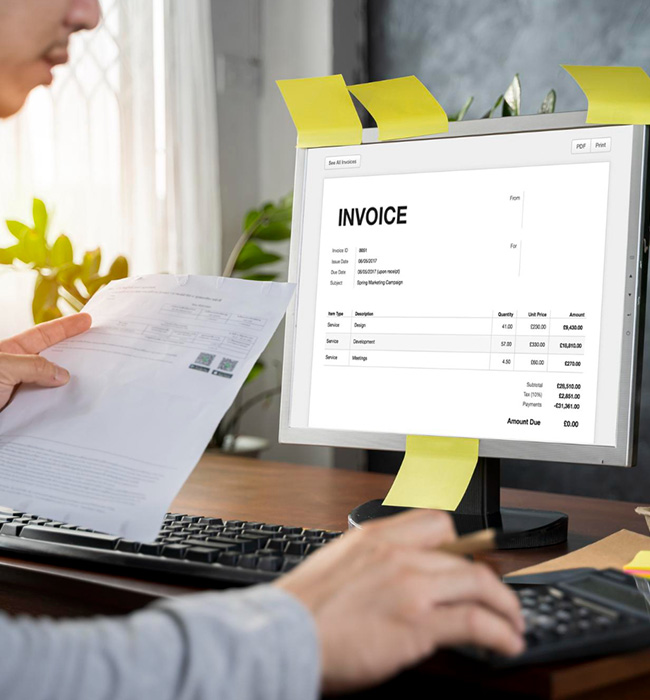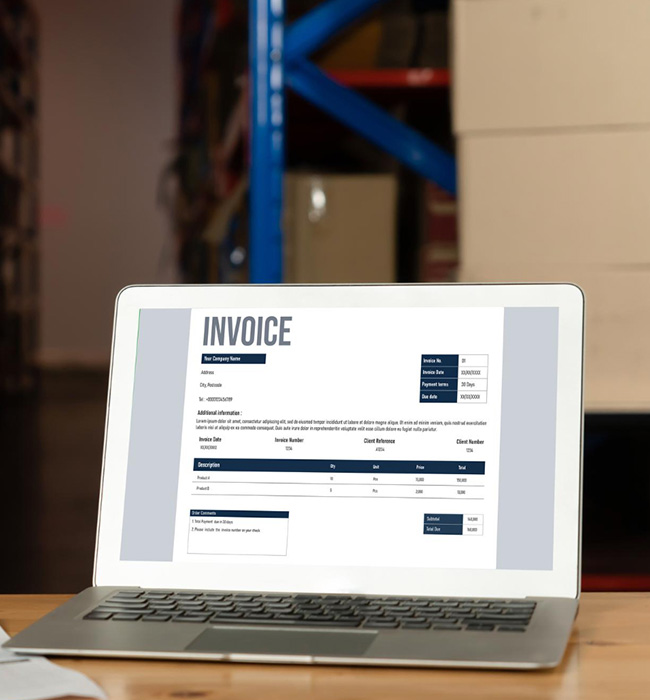e-Invoice
e-Invoice is an application created by the Revenue Administration in order to ensure the circulation of invoices between the seller and the buyer in a safe and healthy way, which includes the information that must be included in an invoice in accordance with the Tax Procedure Law, which is issued in the form of an electronic document whose data format and standard is determined by the Revenue Administration in electronic environment using an internet connection.

e-Invoice Obligations
| Condition | Start of Obligation | e-Document |
|---|---|---|
| Taxpayers with a turnover of 3 million or more in 2024. | 01.07.2025 | e-Invoice, e-Archive Invoice |
| Taxpayers who realize the sale of goods or services on their own or intermediary service providers' websites or in any other electronic environment, with a gross sales revenue of 500,000 TL and above for the 2024 accounting period. | 01.07.2025 | e-Invoice, e-Archive Invoice |
| Gross sales revenue of 500,000 TL and above for the 2024 accounting period from taxpayers who carry out real estate and/or motor vehicle, construction, manufacturing, purchase, sale or leasing transactions and taxpayers engaged in intermediary activities in these transactions. | 01.07.2025 | e-Invoice, e-Archive Invoice |
| Taxpayers who are registered to the e-Invoice application and whose gross sales revenue is 10.000.000 TL and above in the 2024 accounting period. | 01.07.2025 | e-Waybill |
It is mandatory to start using e-invoice and e-archive invoice by 07.07.2025 at the latest, provided that the
application is made by 01.07.2025.
Taxpayers who do not complete their e-Document transition obligations on time and do not issue documents that require e-Document will be fined up to 1.700.000 TL.

How to issue an e-Invoice?
Since e-Invoice is an application developed by the government, companies can receive services from the GİB Portal or integrator organizations authorized by GİB. During the preparation process, a financial seal must be obtained after applying to the Public Certification Center. e-Invoice is mandatory for businesses included in the General Communiqué on Tax Procedure Law No. 509. However, if you are a company outside of this, you can still apply to the system voluntarily and become an e-Invoice user.
Advantages of e-Invoice
The e-Invoice application, which has no functional difference with the traditional invoice, was developed by the Revenue Administration. The aim of this application was to reduce the use of paper and save time. Indeed, with the e-Invoice application, companies can perform invoice transactions much easier and faster than before. In addition to paper and printing costs, costs such as archiving and distribution are also eliminated with e-Archive invoices. It is possible to manage all invoice transactions in a very practical way through the e-Invoice application. An unlimited number of authorized users can access invoice information and perform transactions through the application. Thus, it becomes easier to plan an invoice operation in accordance with the distribution of tasks with in the company. In addition, since it is issued and stored electronically, it has a much more secure structure.


e-Archive Invoice
Taxpayers registered to the e-Invoice application are obliged to issue e-Archive Invoices for the delivery of goods and performance of services to not taxpayers or taxpayers who are not registered to the application. A newly established business can issue invoices using the Revenue Administration’s free e-Archive invoice system. To use the Revenue Administration’s e-Archive system, a user code and password must be obtained from the Revenue Administration. In addition, in the free e-Archive invoice system, a Turkish phone number is used during the signing of invoices after they are created. Therefore, for our customers who prefer to establish a company remotely through ETITAX, we recommend that they register to the e-Invoice system by obtaining a Financial Seal.
What are the Differences between E-Archive and E-Invoice?
E-Invoice is a digital transformation application whose format and scope is determined by the Revenue Administration and covers the process of creating invoices in digital media and delivering them to the recipient.
E-Invoice, which is not a different type of document, has the same legal rights and validity as invoices issued on paper.
E-Archive; It is the type of invoice in which paper invoice transactions between institutions and individuals outside the scope of electronic invoice application are transferred to the electronic environment. Invoices prepared with the E-Archive system serve as a secure bridge between the sender and the recipient of the invoice.


What are the differences between E-Archive and E-Invoice? First of all, taxpayers who want to benefit from the E-Archive application must be registered in the E-Invoice application. Provided that they are included in the E-Invoice system, any business can switch to the E-Archive application. In order to issue an E-Invoice, both the recipient and the sender must be E-Invoice users. E-Archive Invoice is issued to those who are not E-Invoice users. In short, E-Invoice is sent to companies that are E-Invoice users, while E-Archive is sent to companies that are not E-Invoice users and customers who are end users. In this respect, E-Archive taxpayers are wider. While the invoice created in the E-Invoice is delivered to the recipient via the Revenue Administration (RA) platforms, the E-Archive Invoice is not delivered via RA. At the end of the day, only E-Archive reports containing the header information of the E-Archive Invoices issued are sent to the RA.
While the E-Invoice is created digitally and sent to the recipient, the E-Archive Invoice can be sent to the customer both online and printed on paper. However, if the customer requests a paper invoice, E-Archive users can print the invoice and send it to the customer without adding a stamp or signature. E-Archive, on the other hand, ensures that invoices issued to companies and consumers outside the scope of E-Invoice are issued electronically and the second copy is kept and submitted electronically. While UBL-TR format is mandatory in E-Invoice, the desired format can be used in E-Archive. However, it is recommended by the RA to use UBL-TR format. Each invoice sent in E-Invoice is first transmitted to the Revenue Administration, while in E-Archive, the RA is informed with a report at the end of the day. These are the main differences between E-Invoice and E-Archive Invoice. Taxpayers or non-taxpayer users can perform invoice cutting operations quickly and easily.

Frequently Asked Questions (FAQ)
e-Invoice is issued only between taxpayers registered in the e-Invoice system and transmitted electronically. e
Archive, on the other hand, covers electronic invoices issued for taxpayers not covered by e-Invoice.
e-Invoice or e-Archive invoices must be kept electronically for 10 years from the date of issue.
e-Invoice or e-Archive invoices are stored to be submitted electronically when necessary. The submission
process can be performed as a digital file or by printing it out when necessary.
